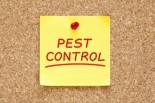Spring and summer is prime time for pests to appear in your home, especially those dreaded ants.
Your initial reaction is to get bait traps or reach for a can of insecticide spray.
The problem is that many of the ingredients contained in these sprays and other methods are linked to an increasing number of illnesses.
For instance, there have been studies showing higher rates of leukemia and brain cancer in kids who lived in homes where pesticides were used. There is a 3-7 times greater chance of developing Non-Hodgkin's Lymphoma for those living in homes where insecticides and extermination methods were applied (inside and outside). In one study, children whose yards were treated with herbicides and insecticides had four times the risk of soft tissue sarcoma. Fetuses are even affected, especially in the last three months of pregnancy.
Some studies have shown that pesticides also reduce kids' IQ scores. Kids are especially prone because they are more likely to play out in the yard, in the grass, and they're also just naturally closer to the ground because of their size.
If you want to protect your family from the harm of these harsh, toxic methods, what are some alternative options?
Lisa Beres, Certified Green Building Professional, suggests following the Integrative Pest Management (IPM) movement. This movement aims to use the least toxic approach possible. For instance, follow the trail of those ants, and fill the entry holes with non-toxic caulking. Also, don't leave food out; store dry food in tightly sealed containers. And, make sure trash is covered.
You can also use red chili powder, paprika or dried peppermint at the point of entry. This will create a barrier and prevent the ants from spreading.
If you have a pet and want an alternative to highly toxic flea collars, you can feed your pet brewers yeast, either by mixing in with their food or in tablet form.
For other pests, like termites, fleas, cockroaches, spiders, you can mop your floor with a small portion of borax; you just need to be careful if you have little ones, because it an be poisonous if ingested.
The goal, says Beres, is to find the source of where/why the pests are coming into your home and take care of the root problem. Bugs are important to the ecosystem, so just spraying a bunch of pesticides to kill them can disrupt that flow.
In the accompanying audio segment, Beres joins Naturally Savvy host Lisa Davis to share more about non-toxic pesticide options, as well as the dangers of using traditional chemically-infused methods.
Chemical pesticides have been linked to diseases such as cancer. What are some safe, non-toxic alternatives?
Additional Info
- Segment Number: 2
- Audio File: naturally_savvy/1521ns3c.mp3
- Featured Speaker: Lisa & Ron Beres, Certified Green Building Professionals
- Book Title: Just GREEN It! Simple Swaps to Save the Planet + Your Health
- Guest Website: Ron and Lisa: The Healthy Home Dream Team
- Guest Facebook Account: https://www.facebook.com/RonandLisaTheHealthyHomeDreamTeam
- Guest Twitter Account: @RonandLisa
-
Guest Bio:
 Lisa and Ron Beres are Certified Green Building Professionals, Building Biologists and published authors of several books including Just GREEN It! and the children's book, My Body My House. In addition to testing the health of homes, their consulting business includes celebrities and Fortune 500's. They are award winning television media experts and have appeared on The Rachael Ray Show, The Suzanne Show, The Doctors, Fox & Friends, The Today Show with Matt Lauer, NBC’s Nightly News with Brian Williams, Discovery’s Greenovate and Chelsea Lately on E!
Lisa and Ron Beres are Certified Green Building Professionals, Building Biologists and published authors of several books including Just GREEN It! and the children's book, My Body My House. In addition to testing the health of homes, their consulting business includes celebrities and Fortune 500's. They are award winning television media experts and have appeared on The Rachael Ray Show, The Suzanne Show, The Doctors, Fox & Friends, The Today Show with Matt Lauer, NBC’s Nightly News with Brian Williams, Discovery’s Greenovate and Chelsea Lately on E!
- Length (mins): 10
- Waiver Received: Yes
- Internal Notes: repeat guest
- Host: Andrea Donsky, RHN and Lisa Davis, MPH
Published in
Naturally Savvy
Tagged under
